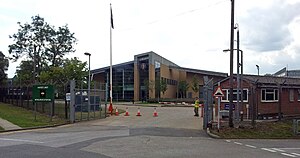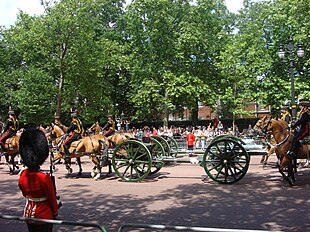King's Troop, Royal Horse Artillery
| The King's Troop, Royal Horse Artillery | |
|---|---|
 Officer (left) and trumpeter of the King's Troop on duty at the Queen's Birthday Parade | |
| Active | 17 April 1946 – present |
| Country | United Kingdom |
| Branch | |
| Type | Saluting Battery |
| Role | Ceremonial |
| Part of | HQ London District |
| Garrison/HQ | Napier (King George VI) Lines,[1] Royal Artillery Barracks, Woolwich Station[2] |
| Nickname(s) | "The Troop" |
| Patron | George VI |
| Anniversaries | Troop Day 24 October |
| Equipment | QF 13-pounder gun |
| Website | The King's Troop RHA |
The King's Troop, Royal Horse Artillery, is a ceremonial unit of the British Army, quartered at Woolwich. It is a mounted unit and all of its soldiers are trained to care for and drive teams of six horses, each team pulling a First World War-era QF 13-pounder gun; six teams are used in the unit's Musical Drive. The Troop's duties include firing salutes on royal and state occasions, participation in parades, and the duties of the King's Life Guard at Horse Guards for one month each year. The unit provides the gun carriage and team of black horses for state funerals.[3] The unit is most often seen providing gun salutes on state occasions in Hyde Park, and Green Park.
History

After the Second World War, King George VI expressed the view that, following the mechanisation of the last batteries of horse-drawn artillery, a troop of horse artillery should be retained to take part in the great ceremonies of state. Accordingly the Riding Troop was reformed on 17 April 1946 at Shoeburyness as a six-gun Royal Horse Artillery battery for the Household Division.[4]
At the suggestion of Brigadier John Anquetil Norman, the King declared that the Riding Troop would be known as 'The King's Troop'.[5] The King issued his proclamation on 24 October 1947 by amending the page on the visitors' book by striking out the word "Riding" and inserting "King's".[6] On her accession, Queen Elizabeth II declared that the name 'The King's Troop' would remain in honour of her father.[3]
On 6 September 1997, members of the King's Troop Royal Horse Artillery carried the coffin of Diana, Princess of Wales on a gun carriage to her funeral.[7]
On 14 September 2022, members of the King's Troop Royal Horse Artillery carried the coffin of Elizabeth II on a gun carriage from Buckingham Palace to lie in state at Westminster Hall. [8]
The King's Troop was for 65 years stationed at St John's Wood Barracks before it was relocated to Napier Lines (also known as King George VI Lines) at the traditional Royal Artillery Barracks at Woolwich in February 2012.[9][10] Because of the greater distance from central London, the troop can no longer ride to many ceremonial events. Horses are transported by vehicle to stables in central London for appearances at Hyde Park, Buckingham Palace and elsewhere.[11]
The King's Troop has about 140 members. Women were able to apply from 1996, and eventually made up about 40% of the Troop.[3]
Role



Musical Drive
The King's Troop Royal Horse Artillery performed their Musical Drive at every Royal Tournament from its formation in 1947 to the final Royal Tournament on 2 August 1999. The Musical Drive can be seen at shows around the United Kingdom and always at the Royal Windsor Horse Show in May every year.[12]
Many of the manoeuvres of the Musical Drive have remained unchanged since it was first performed in 1897. The start, known as the Big Drive, features the Scissors, where the whole team criss-cross at gallop, displaying choreography, teamwork and discipline. Another manoeuvre, the Wagon Wheel, depicts an inner wheel, spokes, and an outer wheel.[13]
For a "Hero's Welcome" event in Windsor in May 2008[14] there were six gun teams, each of ten horses and seven riders. Women, first admitted to the King's Troop in 1996, made up one-third of the display team. Major Erica Bridge was the first female officer commanding the King's Troop.[15]
Trooping the Colour
Together with the Household Division the King's Troop has appeared every June since 1997, when it made its first appearance, at Trooping the Colour, on Horse Guards Parade to celebrate the King's/Queen's Official Birthday. At the end of the event, the King's Troop ranks past the King.[16]
After the ceremony, the King's Troop moves to Green Park, adjacent to Buckingham Palace, firing a 41-gun salute, which is a 21-gun salute with an additional 20 rounds fired because the gun position is in a Royal Park.[17]
King's/Queen's Life Guard
One of the regular duties undertaken by the King's Troop is to mount the King's Life Guard on Horse Guards Parade. Although this is primarily the role of the Household Cavalry Mounted Regiment, every summer this unit goes away for 2–3 weeks for summer training (and to provide a break for their horses) to Norfolk. During this period, the King's Troop takes over responsibility for providing the mounted sentries.[18]
Order of precedence
In the British Army Order of Precedence, the Household Cavalry is listed first and normally parades at the extreme right of the line. However, when the Royal Horse Artillery is on parade with its guns, they take on the honour of taking right of the line.[19]
Film The Troop
A 35mm CinemaScope film, The Troop, was filmed in Windsor Great Park and at 'The Wood' barracks. The film had a royal premiere before the Princess Royal at BAFTA in September 1999.[20] The Glory Film Co. production was produced and directed by Marcus Dillistone, the associate producer was Paul-Anthony Viollet (a former Troop Officer) and the introduction was spoken by Sir John Mills. Music was composed by Julian Scott and performed by the Royal Philharmonic Orchestra.[21]
See also
- British Army
- Honourable Artillery Company
- List of Royal Artillery Batteries
- Royal Artillery
- Royal Horse Artillery
- Royal Tournament
- Trooping the Colour
Notes
- ^ Tom Sables (27 November 2020). "Is Your Military Base Closing? Read The Full List Of Sites Shutting". Forces Network. Archived from the original on 5 August 2021. Retrieved 12 June 2021.
- ^ Trooping the Colour: The Queen's Official Birthday 2021, BBC, retrieved 12 June 2021
- ^ a b c Robinson, Helen (n.d.). "The King's troop & I". The Lady. Retrieved 7 February 2022.
- ^ Clarke 1993, p. 113
- ^ Obituary of Brigadier J. A. Norman, The Times, March 1994
- ^ "The King's Troop Royal Horse Artillery - Our History". Army. Retrieved 7 February 2022.
- ^ "Palace Announces Further Changes to Funeral Route". BBC News. 6 September 1997. Retrieved 25 October 2023.
- ^ "Her Majesty The Queen's coffin procession to Westminster Hall". Royal Family Website. 14 September 2022. Retrieved 25 October 2023.
- ^ King's Troop RHA moves into state-of-the-art facilities in Woolwich Defence News, 8 February 2012
- ^ King's Troop moves to its 'spiritual home' in Woolwich at BBC News, 7 February 2012. Accessed 8 February 2012
- ^ Moore-Bridger, Benedict King's Troop hoof it 15 miles to new barracks Evening Standard, London 8 October 2008. Accessed 3 February 2012
- ^ "Sunday Programme". Royal Windsor Horse Show. Retrieved 1 September 2020.
- ^ "County show thrives in the rain". Haselmere Herald. 29 May 2014. Retrieved 1 September 2020.
- ^ "A Heroes Welcome". BBC One, 11 May 2008
- ^ Roya Nikkhah "King's Troop prepares for Royal Tattoo". The Daily Telegraph, 13 April 2008
- ^ "Trooping the Colour". Royal Family.
- ^ "Trooping The Colour". Coach Holiday News, 31 May 2011
- ^ "New Faces at Horse Guards". British Guild of Tourist Guides. 18 July 2017. Retrieved 13 July 2019.
- ^ "The Royal Regiment of Artillery". British Army units 1945 on. Retrieved 23 April 2014.
- ^ The Troop Film – Royal Premiere at BAFTA at Glory Film Co.
- ^ The Troop—An Epic Short Film Archived 7 November 2017 at the Wayback Machine at Glory Film Co.
Bibliography
- Clarke, W.G. (1993). Horse Gunners: The Royal Horse Artillery, 200 Years of Panache and Professionalism. Woolwich: The Royal Artillery Institution. ISBN 09520762-0-9.
External links
- Official site
- Col Anand We Gunners An (unofficial) History of the Royal Regiment of Artillery
